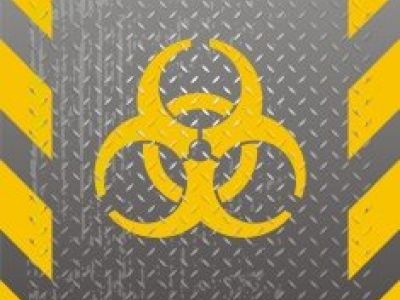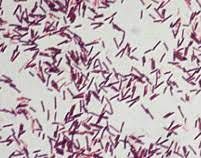Microbiologists Respond to Bioterrorism

In the wake of terrorist attacks on the World Trade Center and Pentagon on September 11, 2001, a group of microbiologists worked with the FBI to identify the individual or group who mailed letters filled with anthrax to American government officials and media personalities. Others struggled with the issues of whether and how to publish research results of potential use to terrorists.
- What kinds of assistance, if any, should civilian researchers give the military in finding terrorists who use biological weapons?
- If researchers successfully make a dangerous pathogen resistant to common treatments, what kinds of things should they consider as they make publication decisions?
Bioterrorism after 9/11
Shortly after the September 11, 2001 terrorist attacks on the World Trade Center in New York City and the Pentagon in Washington, D.C, letters loaded with Bacillus anthracis spores were mailed to various U.S. government officials and media personalities. At least twenty-two people contracted anthrax from the letters. Five died, and seventeen survived, but only after long and debilitating illnesses.
How Did Scientists Respond to Public Interests?
The anthrax attacks catalyzed responses to bioterrorism by individuals and groups of scientists wanting to act in the public's interests. Scientists developed:
- A new research field – Microbial Forensics – to help identify the source of the anthrax attacks
- New guidelines on publishing research to limit terrorists' access to advanced research in microbiology they might use for developing bioweapons
Microbial forensics: Searching for the perpetrator
Claire Fraser-Liggett and other sequencing experts from Craig Venter's Institute for Genomic Research (TIGR) assisted the FBI in identifying the source of anthrax used in the 2001 attacks. Important scientific work included:
- Developing a library of over a thousand anthrax samples
- Pinpointing distinct morphotypes, or mutant colonies of anthrax, growing in cultures of the attack strain as an important way to identify the source
- Sequencing the anthrax genome, including the morphotypes
This research made important contributions to the FBI's identification of a scientist employed by the U.S. military at its leading biological warfare countermeasures facility at Fort Detrick, Maryland as the main suspect in the anthrax attacks. While debate continues on whether this suspect committed the crimes, novel research complemented traditional criminal investigations and made possible the identification of likely sources of the Bacillus species used in the postal mailings and suspects.
Publication guidelines: Keeping advances out of terrorist hands
After 9/11, keeping terrorists from obtaining information that they could use in developing bioweapons became an increased area of concern. Publication of journal articles in Science, Proceedings of the National Academy of Sciences (PNAS), and Journal of Virology that provided details for making infectious agents more lethal and the manufacture of active poliovirus from commercially available information and materials led to debates on the topic. This kind of research has come to be called "dual-use" research because, while it can be used to broaden scientific knowledge and improve public health, it can also be used in terrorist attacks or other nefarious activities.
How did scientists respond? The American Society for Microbiology (ASM) – a professional society with over 42,000 members – and its then president Ronald M. Atlas became a strong voice for both defending scientific commitments to openness in publication and insisting scientists take an active role in stopping bioterrorism.
In respect to the publication of research of potential interest to terrorists, the ASM and Atlas:
- Participated in a National Academy of Sciences meeting between scientists and federal security experts organized so the groups could learn about others' perspectives on publishing research of potential use by terrorists
- Instituted formal procedures in all 11 ASM journals that article reviewers must comment on the possible misuses of microbiology
- Reaffirmed parts of the ASM Code of Ethics that "discourage any use of microbiology contrary to the welfare of humankind, including the use of microbes as biological weapons"
- Specified that additional pre-publication review is needed for research that:
- Makes genetic changes in pathogens (e.g., SARS virus), such that the pathogen could more easily be engineered in the laboratory
- Renders a vaccine ineffective
- Confers resistance to certain antibiotics
- Increases the transmissibility of a pathogen
- Alters the host range of a pathogen
- Makes a pathogen less easy to detect
- Makes a pathogen more deadly, or in effect, "weaponizes" the microbe or its toxins
Scientists' Social Responsibility and Bioterrorism: Questions to Consider
Since the early 2000s, ASM has been consistent in its message: To enhance biosafety, microbiologists need to build a culture of responsibility across the scientific community and embrace the premise that the misuse of science is absolutely wrong.
Microbial forensics
- When new applications of forensic science create risks for individuals and legal systems, who might be at increased risk? Who is responsible for mitigating these risks?
- Which organizations in the scientific community might be best suited to explain the realistic uses and limits of applications of microbiology to forensics? What kinds of strategies could they use?
Bioterrorism and research design
Imagine that, after several years in a NIH-funded research lab, a student has finally decided on a dissertation topic. He wants to engineer a mosquito-borne virus to grow in Drosophila. However, he is not working with just any virus. He has chosen the virus that causes West Nile Fever.
He is convinced that the project shows a high regard for social responsibility since one outcome of the work may be progress on a vaccine to prevent West Nile infection.
- Could enabling a known human pathogen to infect fruit flies pose a danger to public health?
- Could terrorists make use of the methods or results of the proposed experiment?
- Should the student submit the work to a review committee? Which one?
- What are some possible scenarios that might occur if the student went ahead with his research and submitted a full description of the methods and results to an ASM journal?
- Could he re-design the research to achieve his goals without expanding the host range of a pathogen?
Additional Resources
- Committee on Review of the Scientific Approaches Used During the FBI's Investigation of the 2001 Bacillus anthracis Mailings, Board on Life Sciences, & Committee on Science, Technology and Law. (2011). Review of the scientific approaches used during the FBI's investigation of the 2001 anthrax letters. Washington, D. C.: The National Academies Press.
- Keel, B. A. (2004). Protecting America's secrets while maintaining academic freedom. Academic Medicine, 79(4), 333-342.
- Shachtman, N. (2011, April). http://www.wired.com/magazine/2011/03/ff_anthrax_fbi/ Wired, 19(4).
- Skane, W., Walsh, J., & Luwam, Y. (2011, February 15). http://www8.nationalacademies.org/onpinews/newsitem.aspx? News from the National Academies.
This case is based upon work supported by the National Science Foundation under Grant No. 1033111. Any opinions, findings, and conclusions or recommendations expressed in this material are those of the author(s) and do not necessarily reflect the views of the National Science Foundation.
Our project team and advisory board read many drafts and provided important insights. Project team: Heather Canary, Joseph Herkert, Jameson Wetmore, Ira Bennett, and Jason Borenstein. Advisory board: Joan Brett, Jim Svara, Richard Fish, Juergen Gadau, Shelli McAlpine, Timothy Newman, Byron Newberry, Patrick Phelan, and Petra Schroeder.


